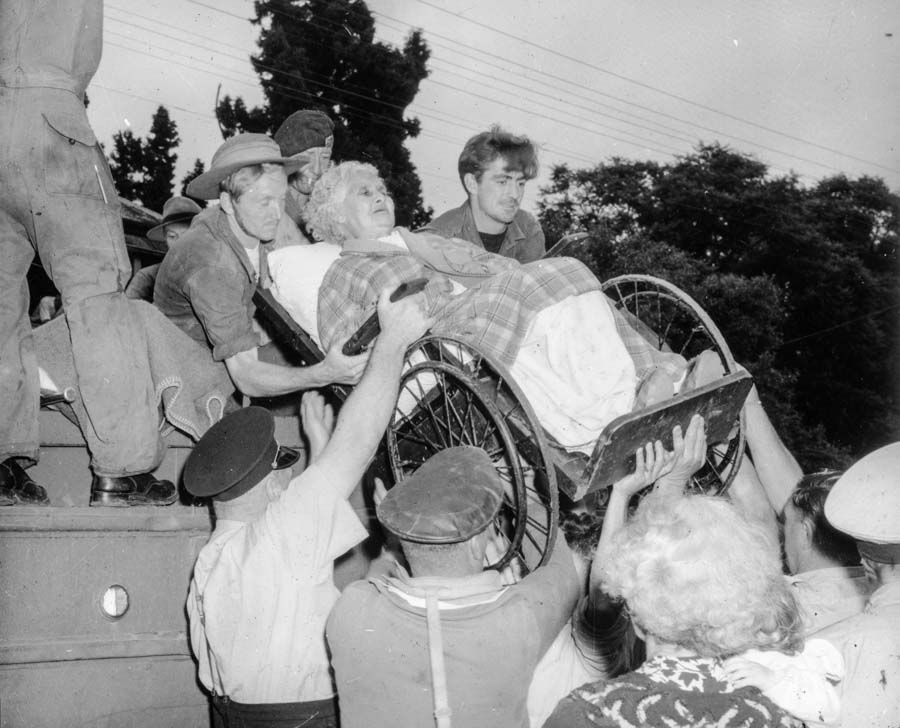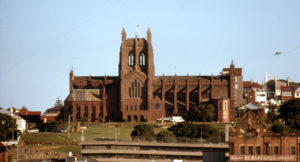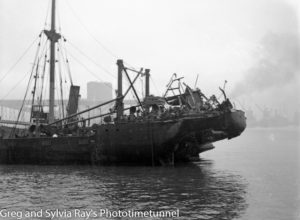Trucks
WHEN senior officers at Williamtown RAAF base called for volunteers to take the base construction crew’s big, high-level trucks to help in Maitland on the afternoon of Thursday, February 24, 1955, Corporal Jim Carney, a 24-year-old air force accountant who had served in Korea, put his hand up. He had been planning a visit to the Newcastle Show with his fiancée, Elaine Frear, who was turning 21 next day. “At 10am they asked for volunteers for a few hours,” Jim recalled. “I ended up being there three days. I had a lot of explaining to do with my fiancée.”
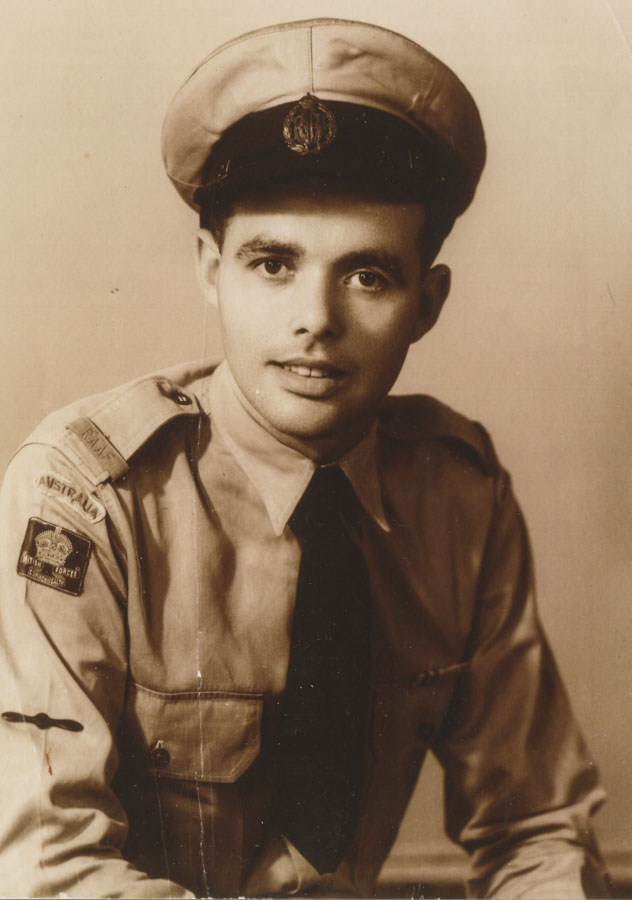
When Jim first arrived at Maitland and set to work behind Sempill Street he almost regretted volunteering. “Standing on the truck made us level with the river bank and at eye level was the great expanse of the Hunter River. Water was up to the axles of our vehicle and I was thinking I’d survived typhoons in Japan and a war in Korea only to end up drowning in Maitland.”
Jim and the other RAAF men set to work, however, and transported many people to the supposed safety of the courthouse. Within an hour the courthouse and police station were flooded so the refugees had to be transported to the high school where rescued and rescuers spent the night, wet to the skin, on benches, floors and in cloakrooms.
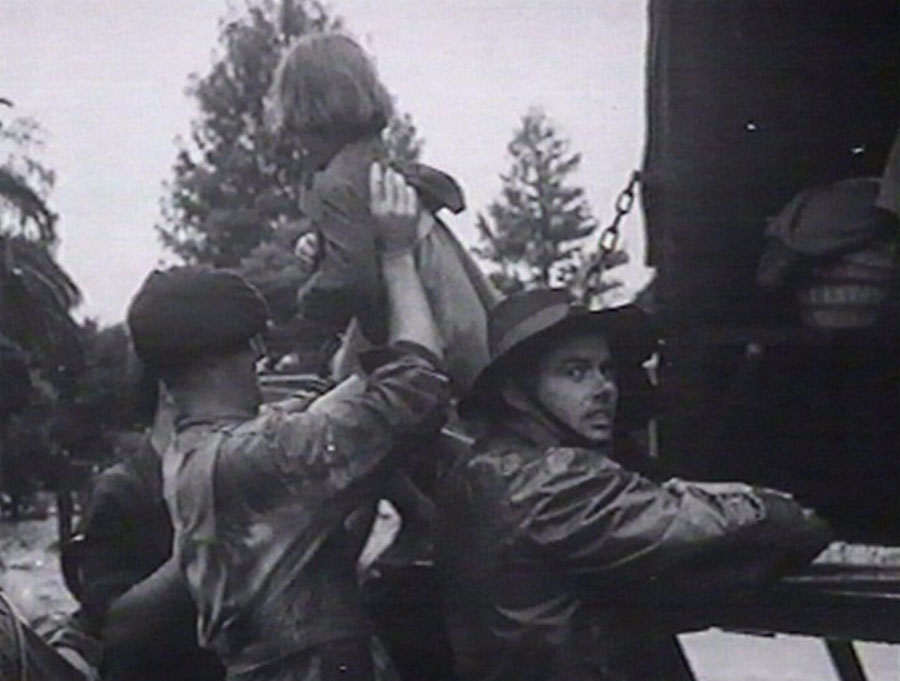
“The next day we found that we were trapped and joined a throng of reporters and cameramen in high street, near the post office, where there were still operating phone boxes. The reporters used the post office to phone through their stories and the airmen to explain to wives and girl friends why they were missing. Surf lifesavers continued their work by boats and the army had ducks but the RAAF trucks were of no more benefit in deep water. We watched in awe as the water gradually crept up high street and parked vehicles eventually floated away to join the cattle, houses and snakes heading downstream to Newcastle. FJ Holdens floated well, Standard Vanguards had only a few minutes before they sank,” Jim wrote.
“On the Sunday we were still trapped but could access the Belmore bridge and many Lorn families took in refugees. In September 1955 i joined the commercial refrigeration industry and we sold the first deep freezers to Newcastle shops so that they could sell frozen food to compensate for the loss of crops in the Hunter Valley and other areas of NSW.”
DUKWs
When the US army left Australia after the Pacific war, it left behind a considerable fleet of amphibious trucks. These were known as “ducks”, a title derived from the General Motors manufacturer’s code name of DUKW.
The manufacturer’s code was used to identify the different vehicles in the GM range. In this case it works as follows;
D = Date 1942 – the first year of manufacture.
U = Amphibian.
K = Drive to all wheels.
W= Dual rear axles.
The similarity with he word “duck” is purely fortuitous.
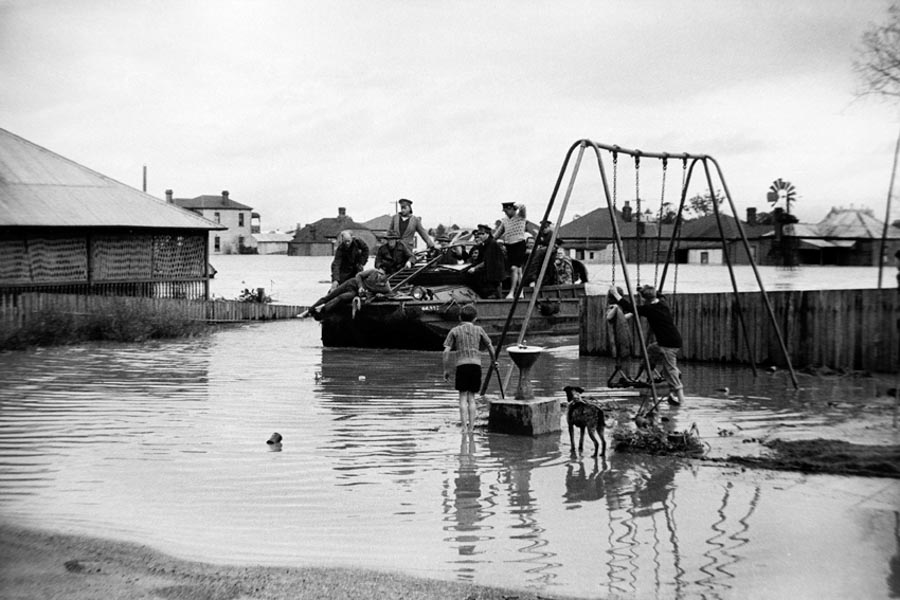
The DUKW was a three-tonne truck with a boat built around it. It could travel at 110 km/h on land and was reasonably useful in the water. It was supposed to carry a maximum 30 passengers, but soon flood workers were to prove it could carry more than twice that number.
Among the many who crewed the DUKWs at Maitland was Constable Ray Mann, a traffic policeman from Newcastle who is said to have attended 13 floods in Maitland and 11 at Kempsey during his career. In 1955 he was in charge of a DUKW he dubbed “B.O. Plenty” after a character in the popular cartoon strip Lil Abner, and also referencing the atmosphere in a craft carrying dozens of unwashed refugees and rescuers. He was badly hurt when his DUKW hit a wire, tearing his mouth from ear to ear, hurt again carrying a child down submerged stairs when the stairs collapsed, and nearly killed trying to free a stranded DUKW from a wire fence.

In the early 1950s the authorities had placed its fleet of DUKWs at strategic positions around NSW, specifically to respond to flood crises. There were two based at Grafton, two at Lismore and four at Newcastle, with another 10 in Sydney.
The DUKWs were superb machines in relatively calm water but were hard to manoeuvre in the raging floods. They weren’t powerful enough to beat the current and if the helmsman steered a little off-line, they were easily spun sideways. They did wonderful work during the floods, especially when the water flow calmed down.
Surfboats
FOR hundreds of people clinging to rooftops, trees, bridges and pieces of shattered haystack during the darkest hours of the floods at Maitland, there was only one real prospect of rescue: surfboats.
A new kind of floodboat had been designed, based on experiences in past floods. It was a small, open boat with a powerful little outboard motor. But by 1955 only two had been built. Both were rushed to the Hunter Valley and though they were found to be excellent for most purposes there were far too few of them and they were limited in some situations. Floating debris frequently damaged their rudders and propellers and made them inoperable.
Helicopters were few and far between and their use in civilian rescues was barely proven. At any rate, there were none based at Williamtown RAAF base in those days and when the emergency was first declared the available choppers were at Nowra, Woomera and aboard warships many kilometres away.
In the 1949 flood at Maitland, surf boats from Newcastle had been used to get supplies to stranded people, and the enormous manoeuvrability and versatility of the craft had not gone unnoticed. With five strong and trained rowers aboard a surfboat could go places and do things that no other craft could do.
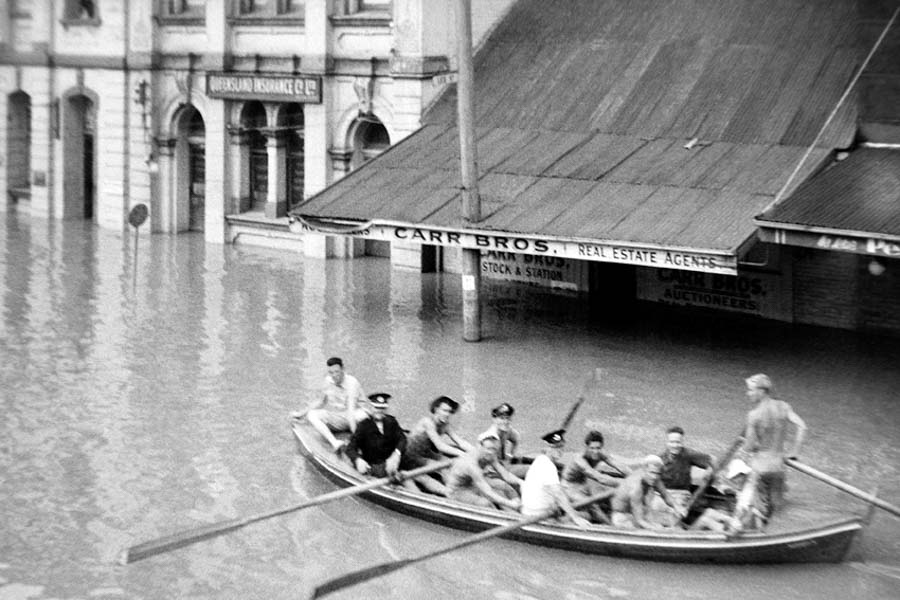
At 11am on Friday February 25, 1955, Maitland’s Mayor broadcast an urgent call for help from any surf clubs that could put together a crew and get their boats to the scene. The police contacted Newcastle surf clubs and within an hour 40 men and four boats had been volunteered.
Laurie March of the Merewether club got a call from the police asking him if he could scratch up a crew and join a convoy to Maitland. “Luckily our A-crew was available so we grabbed our gear,” he said. “The police were brilliantly organised. They had a truck ready to take both our boats and we got to Melbourne Street, East Maitland, about one o’clock in the afternoon. We launched there and the police told us to get around the houses and buildings and pick up everybody we could,” Laurie recalled.
“A lot didn’t want to leave but the police told us to use force if we had to. They had been told the river was going to rise like buggery. The water was a metre deep at Melbourne Street near the Frys building and the current was huge. You had to battle against the current, watch for eddies and try to make your way in the more calm bits of water. You couldn’t go in the actual river: it was too fierce, you’d never survive.”

Other clubs rushed to help and boats came in from Nobbys, Newcastle, South Newcastle, Stockton, North Stockton, Cooks Hill, Redhead, Swansea-Belmont, Swansea-Caves, Merewether, South Newcastle, Dixon Park, Catherine Hill Bay and Lake Macquarie Yacht Club. Crews raced up from Avoca, Toowoon Bay and the Entrance and their help was deeply appreciated. By 6pm Friday it was estimated there were at least 16 boats and 200 crewmen at the disposal of the police.
The Dixon Park crew had a shocking stroke of bad luck. Launching their boat at Melbourne St at about 6pm on Friday they hit a submerged post office box and holed their boat, putting them out of action. It’s a wonder there weren’t more similar accidents.
Surfboats rescued 1800 people
All through the afternoon and night the surfboat crews – and many other people in all kinds of boats – patrolled the treacherous waters rescuing the stranded. Three boat crews alone rescued more than 300 people from rooftops, awnings and floating debris. It has been estimated that surfboats from 15 clubs rescued 1800 people and ferried 600 to safety during the course of the flood across the Lower Hunter.
Several rescues were made by lifesavers swimming long distances with belt and line. Jim Bartley of North Stockton Surf Club four times dragged a line 150m through raging waters to make rescues near the courthouse on Friday night.
A witness, looking from an upstairs window in central Maitland on Friday night described how six men attempted to row a boat up High St on a mercy errand. “I see the craft tossed about crazily by currents coming out of side-streets. There is a crash of glass as it is hurled against a shop window.”

Laurie March said the boat crews were boarded in East Maitland overnight on Friday, but the police woke them very early on Saturday and set them to one of the hardest day’s work of their lives. “They asked us did we think we could get through to West Maitland. That was a big row, against the current all the way, but we did it. We got sent into Mount Pleasant Street, where the houses were washed away and there were people stranded on rooftops. “It was a hard slog all day,” he said. “Normally our crew never argued, but this time we were all that frayed we were disagreeing about everything.”
Mr March estimated the crew did 20 trips on Saturday, rescuing between three and five people each time. And not just people. “People had chooks in sugar bags, dogs, cats. Somebody had a cocky in a cage. On our way up we passed a haystack with a cat and a kitten at one end and a big carpet snake at the other. The snake had two bulges in him, so we reckon he ate two kittens. We saved the cat and the kitten and one of our blokes kept them for years down at Merewether. The snake went down the river.”
Most of the people rescued were in a state of shock, but that didn’t stop them being grateful. “They were so grateful it was amazing. They all wanted to pay us and a lot left money in the bottom of the boat. We tried to give it back but they refused to take it. At the end of the day we had 20 pounds so we donated it to the flood appeal.”
The boats took the evacuees to high ground at the back of the hospital where their names were recorded. They were taken by ambulance to the hospital and checked for injuries before being sent home or to evacuation centres.
One of the greatest boat rescues
“We heard that the Swansea boat took some people off the Long Bridge during the peak of the flood on Saturday. I have to admit they were a better crew than us, but I’ll never know how they carried that off. When you consider the location and the conditions they were dealing with that was one of the greatest boat rescues I have ever heard of,” Laurie said.
“Our second boat rescued six people off a broken-down duck.”
The only time during the drama that Mr March said he was frightened for his life was nearly at the end of their stint at Maitland when the police said they had a report of people stranded in a house up-river near the gasworks. “We didn’t want to go. It was a very big ask and very dangerous because it was a long way and close to the quick current near the river. But we couldn’t say no when people’s lives might be at stake, so we started rowing. You had to dodge the worst bits and sometimes to go 50m straight across in a place you’d have to row 200m upstream. We got to this house where the people were supposed to be but there was no sign of life. We yelled out but got no answer. Then we went round the back and went inside and here was an old man and woman sitting on a bed saying their prayers. “I took a look out the front at the river and it was one of the scariest things I’ve ever seen.”
All the boats had similar stories. One surfboat battled for 90 minutes to travel 20 metres at Wallis Creek on Saturday night, because a huge mass of water hyacinth blocked their way.
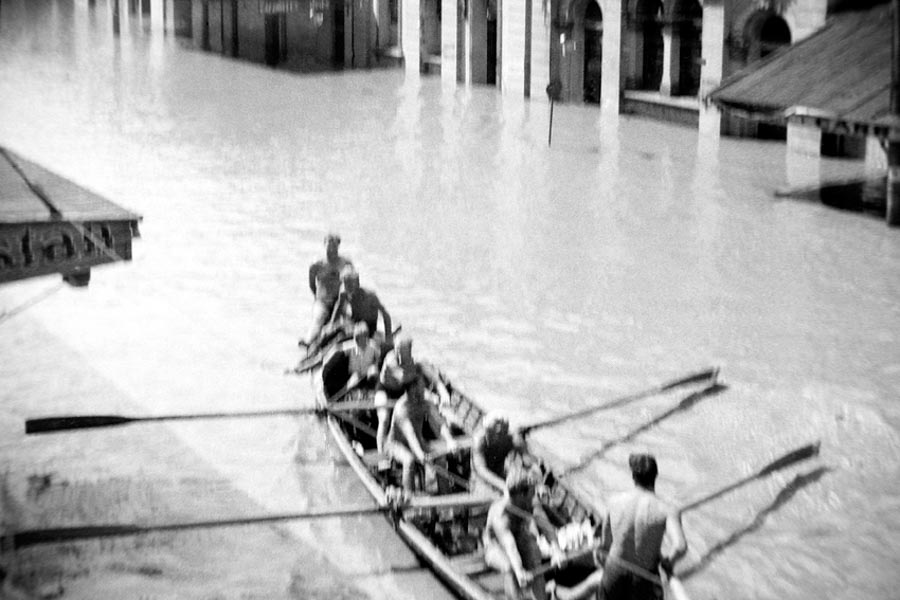
A family was stranded near Brush Farm, between East Maitland and Morpeth. A surfboat crew set out, making the trip with the current with relative ease. The way back, however, was a different story. A witness described how the crew had to stop twice to rest, with one man holding the branches of a submerged willow while the others took a breather. By the time they fought their way back the men were all practically exhausted. Interviewed at the time a Redhead veteran said he had cut his teeth in the surf, but the floodwaters really scared him.
At Millers Forest one of the Stockton boats rescued a man, his wife and their six-month-old baby from on top of a haystack inside a barn, but as they were leaving the area the boat was caught against telephone lines and capsized. Crew member Harry Rowlatt said the family quickly resurfaced and the crew put them into the swamped boat and dragged them to a house roof that was sticking out of the water. “We put the family on the roof, pulled the boat up and emptied it. Then we all got in again and rowed to the Terrace.”
Worked until they dropped from fatigue
A policeman who witnessed the work of the surfboats paid tribute to the crews whom he said “worked until they nearly dropped from fatigue. Without them the death toll would have been much greater.”
So grateful were 114 East Maitland residents that they all signed a letter to the Hunter branch of the Surf Life Saving Association: “Let us assure you that so long as one of us remains, your service will not be forgotten” they wrote. Maitland never forgot the job the surf clubs did and the city invited them back for a street march and presentation in 1956. An estimated 10,000 people lined the streets and cheered and the clubs were showered with gifts of money and mementoes. Each of the 16 clubs was given a plaque and an elaborate shield was presented to the Hunter branch of the Surf Life Saving Association.
And 14 years after the floods, out of the blue came another rich dividend for the surf clubs’ work. Rich Bolwarra widow Mrs Stella Capper, whose husband’s family owned the big hardware concern in Maitland, died in 1969 and left $160,000 to the branch. Mrs Capper, who ran many charitable functions from her mansion, Shenstone, had been widowed when her husband was killed early in World War 2. Her bequest, vast in its day, was invested and the interest kept the life saving movement afloat for years. For decades the Stella Capper surf carnival trophy survived as a tribute to this substantial gesture of gratitude.

